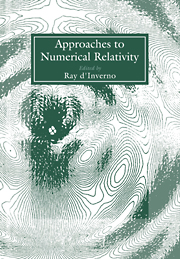Book contents
- Frontmatter
- Contents
- Contributors
- Introduction
- Preface
- PART A THEORETICAL APPROACHES
- PART B PRACTICAL APPROACHES
- Numerical asymptotics
- Instabilities in rapidly rotating polytropes
- Gravitational radiation from coalescing binary neutron stars
- “Critical” behaviour in massless scalar field collapse
- Godunov-type methods applied to general relativistic stellar collapse
- Astrophysical sources of gravitational waves and neutrinos
- Gravitational radiation from 3D gravitational stellar core collapse
- A vacuum fully relativistic 3D numerical code
- Solution of elliptic equations in numerical relativity using multiquadrics
- Self-gravitating thin discs around rotating black holes
- An ADI scheme for a black hole problem
- Time-symmetric ADI and causal reconnection
- The numerical study of topological defects
- Computations of bubble growth during the cosmological quark-hadron transition
- Initial data of axisymmetric gravitational waves with a cosmological constant
- PANEL DISCUSSION
Gravitational radiation from coalescing binary neutron stars
Published online by Cambridge University Press: 15 December 2009
- Frontmatter
- Contents
- Contributors
- Introduction
- Preface
- PART A THEORETICAL APPROACHES
- PART B PRACTICAL APPROACHES
- Numerical asymptotics
- Instabilities in rapidly rotating polytropes
- Gravitational radiation from coalescing binary neutron stars
- “Critical” behaviour in massless scalar field collapse
- Godunov-type methods applied to general relativistic stellar collapse
- Astrophysical sources of gravitational waves and neutrinos
- Gravitational radiation from 3D gravitational stellar core collapse
- A vacuum fully relativistic 3D numerical code
- Solution of elliptic equations in numerical relativity using multiquadrics
- Self-gravitating thin discs around rotating black holes
- An ADI scheme for a black hole problem
- Time-symmetric ADI and causal reconnection
- The numerical study of topological defects
- Computations of bubble growth during the cosmological quark-hadron transition
- Initial data of axisymmetric gravitational waves with a cosmological constant
- PANEL DISCUSSION
Summary
Abstract. We present three-dimensional Newtonian and post-Newtonian codes, including the gravitational radiation damping effect, using a finite difference method. We follow the emission of gravitational radiation using the quadrupole approximation. Using these codes we calculate the coalescence of a neutron star binary. For Newtonian calculations the initial configuration is given as a hydrostatic equilibrium model of a close neutron-star binary. Calculations were performed for neutron stars of different masses as well as of the same masses. In order to evaluate general relativistic effects, we compare the results of the calculation of the coalescence of a binary comprising two spherical neutron stars using the post-Newtonian code with results using the Newtonian code.
INTRODUCTION
The most promising sources for laser-interferometric gravitational-wave detectors are catastrophic events such as the gravitational collapse of a star or the coalescence of a black-hole or neutron-star binary. We need to know the characteristics of the waves for design of detectors. It requires general relativistic calculations of stellar collapse and binary coalescence. In the last decade, 2 dimensional (2D) calculations were successfully performed for a head-on collision of two black holes (Smarr 1979) and axisymmetric collapse of a rotating star (Stark and Piran 1986). They found that the efficiency of gravitational wave emission (the ratio of the energy emitted in gravitational radiation to the total rest mass) is less than 0.1%. Nakamura, Oohara and Kojima (1987), on the other hand, pointed out that the efficiency may be much greater in non-axisymmetric black-hole collision.
- Type
- Chapter
- Information
- Approaches to Numerical Relativity , pp. 182 - 201Publisher: Cambridge University PressPrint publication year: 1992
- 1
- Cited by



